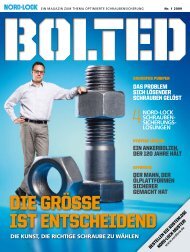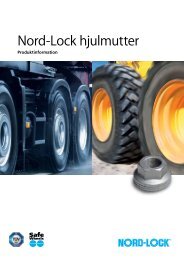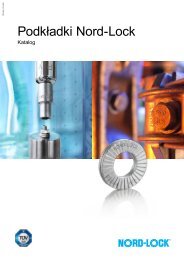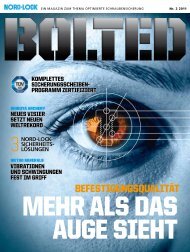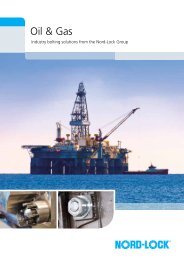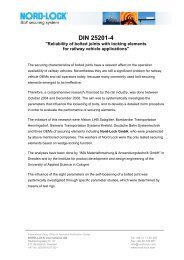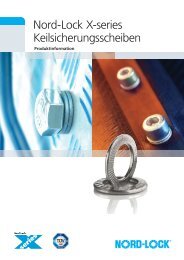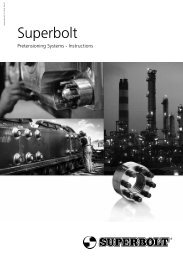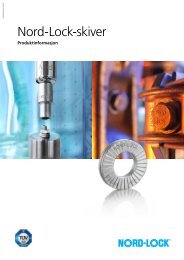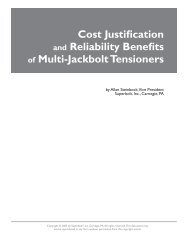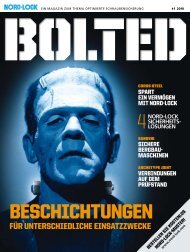Bolted - Nord-Lock
Bolted - Nord-Lock
Bolted - Nord-Lock
- TAGS
- bolted
- www.nord-lock.com
Create successful ePaper yourself
Turn your PDF publications into a flip-book with our unique Google optimized e-Paper software.
A MAGAZINE ABOUT OPTIMISING BOLT SECURING #2 2011<br />
BOLTED<br />
shibuya Archery<br />
new sight<br />
sets new<br />
world record<br />
3<br />
complete washer<br />
programme<br />
certified<br />
nord-lock<br />
security<br />
solutions<br />
metso minerals<br />
controlling<br />
the shake,<br />
rattle and roll<br />
fastener quality<br />
more than<br />
meets the eye
The <strong>Nord</strong>-<strong>Lock</strong> combi bolt<br />
Efficient. Accurate. Cost effective.<br />
The <strong>Nord</strong>-<strong>Lock</strong> combi bolt is a bolt with an<br />
integrated pair of <strong>Nord</strong>-´<strong>Lock</strong> washers. With<br />
the <strong>Nord</strong>-<strong>Lock</strong> combi bolt, you will be able to<br />
increase the efficiency, accuracy and safety of<br />
your assemby, while at the same time keeping<br />
inventory and part count at a minimum.<br />
Based on our proven wedge-locking<br />
technology, the <strong>Nord</strong>-<strong>Lock</strong> combi bolt secures<br />
bolted joints and maintains a high clamp force<br />
even under severe operating conditions.<br />
<strong>Nord</strong>-<strong>Lock</strong> Group • info@nord-lock.com • Tel: +46 (0) 31 7192 300<br />
www.nord-lock.com
olted #2 2011<br />
About optimising bolt securing – a customer magazine from <strong>Nord</strong>-<strong>Lock</strong><br />
A MAGAZINE ABOUT OPTIMISING BOLT SECURING #2 2011<br />
BOLTED<br />
3<br />
complete washer<br />
programme<br />
certified<br />
shibuya Archery<br />
new sight<br />
sets new<br />
world record<br />
nord-lock<br />
security<br />
solutions<br />
metso mineral<br />
controlling<br />
the shake,<br />
rattle and roll<br />
fastener quality<br />
more than<br />
meets the eye<br />
<strong>Bolted</strong> magazine is published by <strong>Nord</strong>-<strong>Lock</strong><br />
and strives to increase knowledge about bolt<br />
assemblies. <strong>Nord</strong>-<strong>Lock</strong> offers a unique bolt<br />
securing system for demanding applications.<br />
The system makes bolted joints self-locking<br />
and does not rely on friction. <strong>Nord</strong>-<strong>Lock</strong><br />
withstands vibration and dynamic loads.<br />
For further information on <strong>Nord</strong>-<strong>Lock</strong>,<br />
visit www.nord-lock.com<br />
<strong>Bolted</strong> is published twice a year in English,<br />
german, Japanese, French, Chinese &<br />
Swedish. it is free to customers of <strong>Nord</strong>-<strong>Lock</strong><br />
worldwide. Published by Tidningskompaniet<br />
in gothenburg, Sweden,<br />
www.tidningskompaniet.se<br />
EdiTor-in-ChiEf:<br />
Carin Esberg<br />
carin.esberg@nord-lock.com<br />
EdiTorial ManagEr:<br />
Susanne Magnusson<br />
susanne.magnusson@tidningskompaniet.se<br />
TranSlaTionS:<br />
Språkbolaget www.sprakbolaget.se<br />
PrEPrESS:<br />
Tidningskompaniet<br />
CovEr PhoTo:<br />
Chubbs1/Tidningskompaniet<br />
Please note that unsolicited manuscripts are<br />
not accepted. Material in this publication<br />
may only be reproduced with permission.<br />
requests for permission should be submitted<br />
to the Editorial Manager<br />
susanne.magnusson@tidningskompaniet.se<br />
Editorial material and opinions expressed in<br />
<strong>Bolted</strong> do not necessarily reflect the views of<br />
<strong>Nord</strong>-<strong>Lock</strong> or the publisher.<br />
Feel free to contact us with any comments:<br />
bolted@tidningskompaniet.se<br />
Printed in Sweden by VTT grafiska. Printed<br />
on UPM Finesse gloss 100 gram and<br />
Maxigloss 200 gram.<br />
<strong>Bolted</strong> is issued for informational purposes.<br />
The information provided is of a general<br />
nature and should not be treated as advice<br />
or be relied upon for making decisions or<br />
for use in a specific matter. Any use of the<br />
information provided is at the user’s sole risk<br />
and <strong>Nord</strong>-<strong>Lock</strong> shall not be liable for any<br />
direct, indirect, incidental or consequential<br />
damage arising out of the use of the<br />
information made available in <strong>Bolted</strong>.<br />
Bringing together two of the most innovative<br />
and trusted bolt securing technologies<br />
I<br />
am happy to inform you that US<br />
company Superbolt Inc and Swiss<br />
company P&S Vorspannsysteme AG<br />
are now part of the <strong>Nord</strong>-<strong>Lock</strong> Group! Just<br />
like <strong>Nord</strong>-<strong>Lock</strong>, Superbolt and P&S offer an<br />
excellent solution that provides maximum<br />
security to bolted joints and holds global<br />
recognition. Read more at www.superbolt.<br />
com and www.p-s.ch. For <strong>Bolted</strong>, this promises<br />
for exciting reading ahead as our Group now<br />
comprises two of the most innovative and<br />
trusted bolt securing technologies! As this<br />
issue of <strong>Bolted</strong> was just about to be finalised<br />
when this news came through, we are looking<br />
forward to investigating this technology further<br />
in our next issue, planned for release in March<br />
(No. 01, 2012)!<br />
Continuing with more good news –<br />
As of this issue, <strong>Bolted</strong> is available in six<br />
languages: English, German, Japanese,<br />
French, Chinese and Swedish! If you have<br />
missed any issues, you can find all existing<br />
<strong>Bolted</strong> editions at www.bolted.com.<br />
04 08<br />
15<br />
CoNteNtS<br />
08 The devil’s in the details<br />
Two identical bolts can perform completely differently.<br />
So what should you focus on when sourcing<br />
fasteners?<br />
12 Smashing rocks<br />
Metso Minerals France’s powerful machines turn<br />
solid rock into sand; but without <strong>Nord</strong>-<strong>Lock</strong>, they<br />
would self-destruct.<br />
04 secured by nord-lock<br />
07 tHe eXPerts<br />
In this issue we focus on fastener quality.<br />
Understanding what makes a good fastener is<br />
the key to high performance over time. Two<br />
bolts that appear identical to the eye may perform<br />
completely differently when placed in demanding<br />
applications. In this issue we provide an overview<br />
on what to focus on when sourcing fasteners (pages<br />
8–11). We also introduce a new service, the <strong>Nord</strong>-<br />
<strong>Lock</strong> E-learning, which enables remote product<br />
training for assembly and maintenance staff (page<br />
18). In my opinion, ensuring that<br />
the product is used correctly is<br />
just as important as choosing<br />
the right product, regardless<br />
of which industry you operate<br />
within! Contact our nearest<br />
representative or email<br />
info@nord-lock.com to<br />
find out more about our<br />
remote product training<br />
tool.<br />
carin esberg<br />
MArkETiNg MANAgEr<br />
15 Staying on track<br />
Professor Uday kumar explains the dynamic forces<br />
railway lines are exposed to and why effective maintenance<br />
is a must.<br />
16 Bullseye<br />
Since switching to <strong>Nord</strong>-<strong>Lock</strong>, Shibuya high-tech<br />
compound archery bows have been used to break<br />
world records.<br />
17 bolting neWs<br />
18 Quality steP by steP<br />
bolted # 2 2011<br />
3
secured by NoRd-loCK<br />
WORDS: NiC ToWNSENd<br />
4 bolted # 2 2011
hIgh seCurIty<br />
The Crystal Tourniket door is<br />
fitted with <strong>Nord</strong>-<strong>Lock</strong> washers,<br />
as are all Boon Edam revolving<br />
doors.<br />
openIng new doors<br />
CuSTOmER:<br />
Boon edam<br />
mODEL:<br />
Crystal tournIket<br />
DOORS iNSTaLLED:<br />
6 (2 at oBservatIon deCk)<br />
hEiGhT:<br />
442 metres<br />
TOTaL hEiGhT OF BuRj KhaLiFa:<br />
828 metres<br />
FLOOR:<br />
124 th (out of 160)<br />
SinCE iTS CoMPlETion last year, the Burj khalifa skyscraper in dubai has<br />
already broken numerous world records. Apart from being the tallest structure<br />
ever built, it also includes the world’s highest restaurant, highest nightclub,<br />
highest elevator installation and highest outdoor observation deck. Leading<br />
to the observation deck are the world’s highest revolving doors.<br />
At a height of 442 metres, the new doors not only have to withstand high<br />
winds and extreme weather conditions, but also have to fit into the building’s<br />
main façade and aesthetic setting. Boon Edam, which has been supplying<br />
revolving doors for over a century and become world leaders in the field, was<br />
a natural choice when it came to selecting a supplier. Boon Edam’s Crystal<br />
Tourniquet revolving door is made of toughened glass and is completely<br />
transparent, making it a perfect combination of style and functionality.<br />
For a number of years now, Boon Edam has been using <strong>Nord</strong>-<strong>Lock</strong> washers<br />
in its revolving doors as it has found that their improved reliability and superior<br />
locking abilities have significantly reduced maintenance costs. Boon Edam<br />
supplied a total of six doors to the Buri khalifa skyscraper, including two<br />
at the observation deck, all of them containing <strong>Nord</strong>-<strong>Lock</strong> components.<br />
bolted # 2 2011<br />
5
iLLUSTrATioN: NENUPhAr<br />
secured by NoRd-loCK<br />
drIll wIth skIll<br />
CuSTOmER:<br />
geawellteCh<br />
hEiGhT:<br />
6 metres<br />
WhEn iT CoMES To drillS, size and horsepower are not everything. in small<br />
confined spaces or sensitive environments, it is more important to have equipment<br />
that is flexible and can drill with finesse.<br />
For these kinds of jobs, Swedish supplier gaewelltech uses its 3050Cr – a<br />
complete drill system centred around a lightweight rig, which allows it to drill in<br />
confined spaces with minimal impact on its surroundings. Yet the 3050Cr still<br />
has the capacity to reach depths of 300 metres quickly and easily.<br />
Such high capacity in a small format puts a lot of stress on both the equipment<br />
and its components, and bolt failure is the most common cause of downtime.<br />
After seeing how effective <strong>Nord</strong>-<strong>Lock</strong> washers were on hydraulic hammers,<br />
geawelltech decided to apply them to the 3050Cr. Today, a 3050Cr is<br />
equipped with around 80 pairs of washers.<br />
PhoTo: gEAWELLTECh<br />
mODEL:<br />
3050Cr<br />
LENGTh:<br />
3.8 metres<br />
6 bolted # 2 2011<br />
DEpTh:<br />
300 metres<br />
WiDTh:<br />
1.7 metres<br />
loCkIng power<br />
SmO washers are currently being used to secure the<br />
connection between the turbine’s blades and its arms.<br />
<strong>Nord</strong>-<strong>Lock</strong>’s unique locking abilities will also keep<br />
maintenance to a minimum.<br />
hORSEpOWER:<br />
55 kw<br />
DRiLL-hOLE DiamETER:<br />
4—6 InChes<br />
WEiGhT:<br />
6,200 kg<br />
the low-Cost wInd energy alternatIve<br />
CuSTOmER:<br />
nenuphar<br />
mODEL:<br />
vertIwInd<br />
FLOTaTiON SYSTEm uNDERWaTER EXTENSiON:<br />
9 metres<br />
hEiGhT:<br />
100 metres<br />
aIdIng flexIBIlIty<br />
a 3050CR is equipped<br />
with around 80 pairs of<br />
<strong>Nord</strong>-<strong>Lock</strong> washers.<br />
OuTpuT:<br />
2 mw<br />
frEnCh ManufaCTurEr Nenuphar is currently on track to make a huge breakthrough<br />
in floating wind turbine technology with its VertiWind project. Unlike traditional wind<br />
turbines, the VertiWind turbine has a vertical axis, which allows for a lower centre of<br />
gravity and a significantly smaller flotation system. it can also be installed in water deeper<br />
than fifty metres, enabling it to capture more powerful and consistent winds further out<br />
to sea. As it does not require a subsea structure, installation costs are significantly lower,<br />
and it can potentially be a low-cost alternative to conventional offshore wind turbines.<br />
Nenuphar is currently working on a full-scale two megawatt offshore prototype, after<br />
successfully constructing a 35 kilowatt onshore prototype last year. once it is launched<br />
at sea, the prototype will be subject to severe stress, so it must be robust. With the help<br />
of <strong>Nord</strong>-<strong>Lock</strong> Performance Services, Nenuphar is continuously optimising and improving<br />
its design, and SMo washers are currently being used to secure the connection between<br />
the turbine’s blades and its arms. <strong>Nord</strong>-<strong>Lock</strong>’s unique locking abilities will also keep maintenance<br />
to a minimum, which will be vital if the VertiWind is to be a viable low cost solution.<br />
By the end of 2013, Nenuphar hopes to have deployed a full-scale offshore turbine<br />
in the Mediterranean Sea.
tHe eXPeRtS<br />
Email your questions about bolt securing to experts@nord-lock.com<br />
ask<br />
tHe<br />
eXPerts<br />
Do you have a question about<br />
bolt securing? Put the <strong>Nord</strong>-<strong>Lock</strong><br />
experts to the test.<br />
Can i use an<br />
additional locking<br />
system?<br />
Q: Can i use an additional locking<br />
system with <strong>Nord</strong>-<strong>Lock</strong> washers?<br />
a: It is recommended to use only<br />
standard fasteners (nuts and bolts)<br />
with <strong>Nord</strong>-<strong>Lock</strong> washers. Other<br />
specialised locking systems, including<br />
prevailing nuts and adhesives,<br />
are not advisable and would not add<br />
any benefits to the joints.<br />
Theoretically, it is possible to<br />
use prevailing nuts and adhesives<br />
together with <strong>Nord</strong>-lock washers,<br />
but they will increase the thread<br />
friction when tightening the joint.<br />
When tightening, less of the torque<br />
can be converted into useful clamp<br />
load because the torque must overcome<br />
the additional friction. Also,<br />
increased thread friction raises<br />
the risk of torsional stress in the<br />
bolt and may lead to unexpected<br />
bolt failures. Additionally, these<br />
systems will add more cost to the<br />
joint.<br />
<strong>Nord</strong>-<strong>Lock</strong> is a reliable, engineered<br />
system and there is no need<br />
to use any additional locking systems.<br />
The superior quality guarantees<br />
excellent tightening control and<br />
the joint is exceptionally secure.<br />
ADhESIvES<br />
NyLON NUT<br />
damien tHomas<br />
FiELd APPLiCATioNS<br />
ENgiNEEr<br />
how do i take torsion into<br />
consideration when tightening?<br />
Q: how do i take torsion into<br />
consideration when tightening<br />
a bolted joint?<br />
a: Torsion is the twisting of the<br />
bolt when applying the tightening<br />
torque. When a bolt is tightened<br />
it is subjected to tensile stress as<br />
preload is introduced but also to<br />
torsion stress as a result of thread<br />
friction. Torsion generates a<br />
shearing stress that is perpendicular<br />
to the radius in the circular<br />
cross section of the bolt.<br />
Bolts are designed to support<br />
a certain stress [N/mm 2 ] before<br />
yielding, known as the yield<br />
strength of the material. Torsion<br />
increases the total stress in the<br />
bolt, which may break at a lower<br />
preload than expected; the greater<br />
torsion stress, the lower the tensile<br />
stress that can be introduced.<br />
Therefore, when designing a bolted<br />
joint, it is important to consider<br />
both tension and torsion in order<br />
The prevailing nut category includes<br />
a multitude of fasteners.<br />
Nylon insert nuts, metal insert<br />
nuts, flex top expanding nuts and<br />
distorted thread nuts are just some<br />
of the products that are available.<br />
These products add friction to the<br />
bolted joint and are more costly<br />
than a standard nut.<br />
Adhesives are a little different<br />
but can cause the same problems.<br />
Some existing adhesives are thread<br />
lockers, joint sealants and thread<br />
sealants. In addition to adding undesirable<br />
friction to the bolted joint,<br />
the option of using a thread lubricant<br />
is also eliminated. A good lubricant<br />
is recommended in order to<br />
reduce friction, further minimise<br />
clamp load deviation and protect<br />
against corrosion.<br />
To optimise your joints it is recommended<br />
to use lubricated standard<br />
fasteners together with <strong>Nord</strong>-<br />
<strong>Lock</strong> washers which will result in a<br />
secure joint, predictable preload and<br />
low deviation. CT<br />
to utilise maximal axial load in the<br />
bolt without yielding it.<br />
It is possible to anticipate the<br />
amount of torsion stress using the<br />
following two methods:<br />
n By calculation, according to<br />
international standards and recommendations.<br />
n By considering that torsion<br />
stress will represent 15% of the<br />
total stress. Nevertheless, in respect<br />
of thread friction, this usual<br />
value can be adjusted: from 10%<br />
if the fasteners are lubricated, to<br />
20% in dry conditions and even<br />
more when using friction-based<br />
locking fasteners.<br />
Since torsion originates from<br />
thread friction, it can be simply<br />
reduced by applying a lubricant to<br />
the threads of the fastener. There<br />
are also tightening methods utilising<br />
tensioning of the bolt either<br />
by hydraulic equipment or special<br />
nuts. Since no turning movement<br />
occurs between the threads, tor-<br />
csaba madru<br />
MANAgEr, gLoBAL dEVELoPMENT<br />
PErForMANCE SErViCES<br />
how much thread engagement<br />
is needed in a tapped hole?<br />
Q: is it possible to determine the<br />
minimum thread engagement in<br />
a tapped hole to avoid thread<br />
stripping?<br />
a: Every threaded joint must fulfil<br />
a simple engineering rule: any<br />
fastener failure must occur in the<br />
shank of the male fastener – bolt<br />
or stud. It implies that the shear<br />
strength of both internal and external<br />
threads overcomes the tensile<br />
strength of the bolt. Therefore the<br />
choice of the fasteners and the design<br />
of the assembly must avoid any<br />
possibility of thread stripping while<br />
making sure the weakest element<br />
in the joint is the bolt or the stud.<br />
The shear resistance of any<br />
thread can be calculated by following<br />
E.M. Alexander’s method 1) , depending<br />
on four main para meters:<br />
APPLIED<br />
TIGhTENING<br />
TORqUE<br />
TENSILE<br />
STRESS<br />
TORSIONAL<br />
STRESS<br />
RESISTING<br />
TORqUE DUE<br />
TO ThREAD<br />
fRICTION<br />
cHris tatak<br />
APPLiCATioNS<br />
ENgiNEEr<br />
sion can be completely eliminated<br />
and a higher axial tension obtained<br />
without any risk of the bolt<br />
yielding. CM<br />
n The Young modulus E of the<br />
material<br />
n The shear strength tm of the<br />
material<br />
n The shear area of the thread,<br />
related to both the clearance between<br />
internal and external<br />
threads, and the effective thread<br />
engagement which is equal to the<br />
depth of tapped holes, minus the<br />
height of entry chamfers.<br />
Nevertheless, tolerance can<br />
mod ify the previous indications:<br />
the wider the thread clearance,<br />
the smaller the thread stripping<br />
load. Calculation tools according<br />
to Alexander’s method can deliver<br />
accurate results. Note also that<br />
<strong>Nord</strong>-<strong>Lock</strong> offers a calculation<br />
service. dT<br />
1) Analysis and design of threaded<br />
assemblies, E.M. Alexander, 1977<br />
bolted # 2 2011<br />
7
fastener quality<br />
all in the<br />
details<br />
Quality fasteners are essential for safe,<br />
economic designs. But what determines<br />
quality, and how do we make sure we<br />
obtain good quality? <strong>Bolted</strong> has conducted<br />
an in-depth study of the subject.<br />
WORDS:<br />
iNgELA rooS<br />
I<br />
iLLuSTRaTiONS:<br />
roBErT hiLMErSSoN<br />
f the wheel nuts on your car come<br />
loose while you’re driving, the<br />
whole car will probably sustain<br />
damage. If a fastener in the engine<br />
breaks the entire car is also at risk<br />
of sustaining damage. The consequences<br />
of a fastener failure tend<br />
to be significant.<br />
“Joining parts together is one of<br />
the most critical steps when delivering<br />
a product or a system. And<br />
the fastener is the key component<br />
in this,” says Maxime Thonnerieux,<br />
Global R&D Director at <strong>Nord</strong>-<strong>Lock</strong>.<br />
It is absolutely crucial that fasteners fulfil<br />
their function. They must be safe and depend-<br />
8 bolted # 2 2011<br />
able throughout the product’s life cycle, and this<br />
is where the quality concept enters the picture.<br />
When we use poor quality fasteners there is<br />
always a risk that parts cannot be assembled at<br />
all, or that they break during assembly. However,<br />
the most serious consequences often occur<br />
when everything seems to be in order during assembly,<br />
and the poor quality gives rise to faults<br />
at a later stage. This may be corrosion, loosening<br />
or fastener failure due to metal fatigue.<br />
“We have seen many such cases where people<br />
have installed fasteners in good faith only for<br />
them to fail later,” says Bengt Sehlå at the<br />
Swedish Institute of Steel Construction.<br />
For example, the less experienced manufacturer<br />
may accidentally expose fasteners to so
olted # 2 2011<br />
9
much heat when applying a coating that hydrogen<br />
migrates into the steel causing embrittlement<br />
and steel strength to fall below the stamped<br />
value.<br />
The first step in ensuring good quality is to<br />
choose fasteners that meet the relevant standards.<br />
For example, in Europe all construction<br />
materials must be CE-marked, which entails<br />
their conformance with basic function and safety<br />
standards and compliance with prescribed inspection<br />
procedures.<br />
“But there may be manufacturers that CE<br />
mark their products without having the right to<br />
do so, which is why it’s advisable for purchasers<br />
to frequently carry out random sample tests to<br />
see if the fasteners meet their standards,” says<br />
Bengt Sehlå.<br />
unforTunaTEly it’s not possible to inspect every<br />
single fastener as it is often a matter of very large<br />
quantities, and the tests destroy the fasteners.<br />
There are also parameters that are difficult or<br />
impossible to check on the finished product, and<br />
which are therefore not covered by the standards.<br />
The best thing the purchaser can do to ensure<br />
he gets good and consistent quality is to set up a<br />
quality acceptance level depending on the potential<br />
consequences affecting the final product and<br />
accept only lower quantities of defected fasteners<br />
(PPM) from the manufacturer.<br />
ManufaCTuring faSTEnErS is a very complex<br />
process. A fastener is not just an object but a<br />
product that must fulfil its function safely and<br />
reliably. Every stage of the manufacturing process<br />
is important to final quality, some stages<br />
more so than others.<br />
Supervision of the manufacturing equipment<br />
is an important element to verify consistent quality.<br />
If a machine performs the same operation on<br />
bolt after bolt, then its load curve should appear<br />
identical every time the machine carries out the<br />
operation. If the load begins to deviate from the<br />
usual curve it’s time to stop the machine and look<br />
for the problem.<br />
The stage most critical to quality depends on<br />
the type of fastener. For nuts and bolts, thread<br />
rolling and the coating are good examples of critical<br />
stages; the coating, because it often involves<br />
temperature variations that may have an adverse<br />
10 bolted # 2 2011<br />
Threads<br />
The standards specify<br />
a number of thread<br />
parameters, but not<br />
the actual shape,<br />
which is difficult to<br />
control. Shape defects<br />
– not even noticeable<br />
beneath the coating –<br />
may give rise to weakened<br />
threads.<br />
Labelling<br />
Batch numbers for traceability. If a<br />
problem occurs, the manufacturer<br />
can re-check the specific batch<br />
from which the fastener came.<br />
Traceability is important for the<br />
manufacturer’s quality management.<br />
Coating<br />
Good quality coatings are not only<br />
important for rust resistance, but<br />
also for ensuring that the applied<br />
torque creates the correct tension in<br />
a joint.<br />
affect on steel strength. It is also important that<br />
the coating is good, particularly in respect of its<br />
capacity to grip the steel, as well as its ability to<br />
ensure sufficient friction. It is friction that determines<br />
the amount of tension in a joint when it is<br />
tightened to a given torque.<br />
“A poor coating may induce a higher or lower<br />
tension than anticipated,” explains Maxime<br />
Thonnerieux.<br />
Excessive tension may cause a fastener to<br />
shear during assembly, while insufficient tension<br />
may lead to bolt loosening or fatigue failure at a<br />
later stage.<br />
hoWEvEr, for washers it is the final coining<br />
that is of greatest importance. A quality-conscious<br />
manufacturer will naturally make certain<br />
that every stage of the manufacturing process<br />
is checked, and be extra thorough with those<br />
stages that are especially critical.
Nuts<br />
It is important that<br />
nuts are manufactured<br />
to the same<br />
standard as bolts, so<br />
that their threads are<br />
cut correctly in relation<br />
to each other.<br />
Otherwise there is<br />
a risk of the threads<br />
stripping at low<br />
torque values.<br />
“it’s advisable for purchasers to frequently<br />
carry out random sample tests to see if the<br />
fasteners meet their standards.”<br />
BENGT SEhLå, ThE SWEdiSh iNSTiTUTE oF STEEL CoNSTrUCTioN<br />
The steel<br />
One of the most important<br />
quality factors. first-rate<br />
manufacturing materials<br />
are the basis of good final<br />
quality. fastener strength<br />
depends largely on the steel’s<br />
composition.<br />
The head<br />
Defects in bolt head shapes hinder<br />
installation. Above all, this applies<br />
to the use of automatic tools.<br />
Unfortunately, the shape is difficult<br />
to check on finished products.<br />
The quality initiatives of a manufacturer<br />
should also extend beyond the factory. Batch<br />
numbers on every fastener permit traceability,<br />
which forms an important part of the total<br />
quality management system. If a customer<br />
suffers problems with a fastener the batch<br />
number allows the manufacturer to re-check<br />
the manufacturing batch and perhaps identify<br />
the root cause of the problem. Sometimes<br />
it is also advisable to notify other customers<br />
that have purchased fasteners from the same<br />
batch.<br />
So, as customers what do we do to make<br />
sure we’ve bought good quality fasteners?<br />
Identifying certification carried out by 3rd<br />
party bodies can be helpful in the search for<br />
quality-conscious manufacturers. The certification<br />
is a guarantee that the company fulfils<br />
precise standards.<br />
MaxiME ThonnEriEux recommends the purchaser<br />
chooses fastener suppliers that can<br />
prove they meet the required standards and<br />
have approvals and certificates from different<br />
industries.<br />
“I would ask the manufacturer how he<br />
could assure me that all his products fulfil<br />
performance requirements.<br />
Are there any occasions when the choice<br />
of high-quality fasteners is of the utmost importance?<br />
“Perhaps in structural applications for<br />
bolts exposed to high loads, temperature variations,<br />
shocks or vibrations, where safety<br />
really matters. But in my opinion, safety matters<br />
every time,” says Maxime Thonnerieux.<br />
Business arguments<br />
n high QualiTy faSTEnErS guarantee high<br />
safety levels.<br />
n high QualiTy faSTEnErS have the correct<br />
shape which aids installation, especially<br />
where automatic tools are used.<br />
n high QualiTy faSTEnErS have good coatings<br />
that protect against corrosion, which<br />
reduces the requirement for rust damage<br />
inspections.<br />
n high QualiTy faSTEnErS significantly affect<br />
life cycle costs. in the long run, they save you<br />
money.<br />
Staying true<br />
to the original<br />
Böllhoff has become one of<br />
the world’s leading suppliers of<br />
fastening, assembly and systems<br />
technology, through its long-standing<br />
commitment to quality. When it<br />
comes to washers, <strong>Nord</strong>-<strong>Lock</strong> easily<br />
fulfils the high Böllhoff standard.<br />
WORDS: NiC ToWNSENd<br />
Böllhoff iS a faMily-run business<br />
based in Germany that goes<br />
back four generations. Today, it<br />
has more than 2,000 employees<br />
and its technology can be found<br />
all over the world. Over time, it<br />
Frank Nientiedt<br />
has built a solid reputation for<br />
high quality, continuous improvement and a zerotolerance<br />
policy when it comes to errors.<br />
“aS far aS QualiTy is concerned, we have no room<br />
for compromise,” says Frank Nientiedt, executive<br />
board member at Böllhoff. “The same is true of<br />
<strong>Nord</strong>-<strong>Lock</strong>.” For the past ten years, the two companies<br />
have been working together. This has proven to<br />
be a highly successful partnership.<br />
To ensure that its high standards such as ISO,<br />
IRIS (International Railway Industry Standard)<br />
and DIN (Ger-<br />
man Institute for<br />
Standardisation)<br />
are maintained,<br />
Böllhoff is regularly<br />
audited by<br />
several accredited<br />
certification bodies.<br />
<strong>Nord</strong>-<strong>Lock</strong><br />
washers have also<br />
been subjected<br />
to similar testing<br />
and have had their<br />
effectiveness verified<br />
by independ-<br />
“as far as<br />
quality is<br />
concerned,<br />
we have no<br />
room for<br />
compromise.”<br />
Frank nientiedt, ExECUTiVE<br />
BoArd MEMBEr AT BöLLhoFF<br />
ent institutions, including the German Federal Railway<br />
Authority (Eisenbahn-Bundesamt, EBA) and<br />
Deutsche Bahn.<br />
SuCh aCCrEdiTaTionS have given Böllhoff full confidence<br />
in <strong>Nord</strong>-<strong>Lock</strong>’s locking capabilities, which is<br />
vital for the safety and reliability of its applications.<br />
It also welcomed <strong>Nord</strong>-<strong>Lock</strong>’s decision in 2011 to<br />
provide laser marking on all its washers. “By labelling<br />
its products, <strong>Nord</strong>-<strong>Lock</strong> ensures that the original<br />
can be distinguished from a copy at a glance,”<br />
says Nientiedt. “This is particularly important in<br />
applications where copies could cause problems.”<br />
bolted # 2 2011<br />
11
good<br />
vibrations<br />
12 bolted # 2 2011<br />
aggrEgaTE The huge machines made by Metso<br />
Minerals France are a mechanical nightmare.<br />
Whereas vibrations are usually eliminated<br />
from machines, the very raison d’être of the<br />
Metso machines is to vibrate as much as<br />
possible in order to sort and grade stones so<br />
they can be used by the construction industry<br />
and, to a lesser extent, in the mining sector.<br />
WORDS:<br />
ChriSTiNA MACkENziE<br />
phOTOS:<br />
NikoLAi JAkoBSEN
Who Would iMaginE that<br />
the burgeoning skyscrapers<br />
emerging from the desert<br />
sands of Dubai and<br />
Abu Dhabi are made with<br />
machine-made sand? The<br />
Emirates are surrounded<br />
by the great wastes of the<br />
Arabian desert and yet all<br />
this sand is useless for making<br />
cement. “The grains are<br />
too perfect, too round and<br />
smooth as they’ve been worn away over aeons<br />
by wind,” laughs Vincent Celsi, Metso Minerals’<br />
Product Manager, Vibrating Equipment for Europe,<br />
the Middle East and Africa. “In order to<br />
make good quality cement the grains need to be<br />
cubic so that they lock together,” he explains.<br />
And so the sand has to be made from rocks<br />
taken from Fujairah, the only Emirate of the<br />
United Arab Emirates that is almost totally<br />
mountainous. The machines that turn rocks into<br />
cubic sand grains by crushing or smashing and<br />
then sorting them into size by vibrating are made<br />
by Metso Minerals France.<br />
The vibrating screens and feeders marketed<br />
by Metso throughout the world are designed and,<br />
in some cases, built in Mâcon in a 51,000 sqmetre<br />
factory which has grown on the picturesque<br />
site bordering the wide, slow-moving and<br />
frequently flooded Saône river in central France<br />
since Joseph Bruno founded a small wood and<br />
iron construction company there in 1867.<br />
david BEllEC, EnginEEring manager for vibrating<br />
equipment mining and construction technology,<br />
says that wherever possible the machines,<br />
some of which are so large they can only be transported<br />
by special road convey, are built close to<br />
the clients. The parent company, Metso Corporation<br />
has over 30 manufacturing units, including<br />
five foundries, throughout the world. “Even if the<br />
manufacturing is regional the overall conception<br />
and design is global,” he says, so that wherever<br />
the machine is built it will be constructed according<br />
to a template designed in Mâcon.<br />
There are three different machines used to<br />
turn rocks into gravel or sand. The “jaw” is a<br />
crusher which can transform a rock that weighs<br />
3 tons and measures 2 m 3 into one that measures<br />
just 40 cm 3 . As its name suggests it works like a<br />
giant jaw, biting down on the rock and crushing<br />
it. The “cone” resembles two shortened icecream<br />
cones placed inside each other: the larger<br />
outer one remains static while the smaller, inner<br />
one vibrates against the walls of the outer<br />
cone thereby crushing the stones that are caught<br />
between the two surfaces. The “impactor” looks<br />
like a water wheel in a box where the blades of<br />
the fast-spinning wheel catch the rocks and hurl<br />
them against the walls of the box, thereby smashing<br />
them.<br />
“The choice of machine depends entirely on<br />
the crushability and abrasiveness of the rocks being<br />
handled,” explains Mr Celsi.<br />
The machines made by<br />
metso minerals France<br />
turn rocks into cubic<br />
sand grains by crushing<br />
or smashing and then<br />
sorting them into size by<br />
vibrating.<br />
bolted # 2 2011<br />
13
“if we didn’t use nord-lock<br />
washers the bolts would<br />
disassemble and the machines<br />
would self-destruct.”<br />
Vincent celsi, ProdUCT MANAgEr AT METSo MiNErALS<br />
In addition there is the “scalper.” This is a<br />
more sophisticated and automated version of the<br />
pan that you see in every cowboy film involving<br />
gold diggers. It also vibrates a lot harder! It is<br />
basically a sieve that vibrates allowing smaller<br />
particles to fall through to the next level where<br />
there is a finer sieve that catches these and allows<br />
even smaller ones to fall through to another level,<br />
and so on. At each level the material is evacuated<br />
by means of conveyor belts and ends up as<br />
those large mounds of differently graded gravel<br />
and sand that can be seen at quarries and at sand<br />
and gravel companies.<br />
WhaT ThESE MaChinES, which range in size from<br />
2.5 tonnes to 40 tonnes, have in common is that<br />
they vibrate “at between 700 to 1,000 turns a<br />
minute causing the particles inside to accelerate<br />
14 bolted # 2 2011<br />
to between 3 and 6 G forces,” says Mr Bellec. “You<br />
can imagine that to make a 40 tonne machine vibrate<br />
you need to produce the equivalent of 160<br />
tonnes of effort,” he says. “By definition this is<br />
self-destructing. Vibration is anti-mechanical,”<br />
he smiles, “and so you need extremely safe and<br />
solid equipment to lock the bolts.”<br />
And that’s where <strong>Nord</strong>-<strong>Lock</strong> comes in. Every<br />
single bolt on these vibrating machines is made<br />
safe with <strong>Nord</strong>-<strong>Lock</strong> washers. “If we didn’t use<br />
<strong>Nord</strong>-<strong>Lock</strong> washers the bolts would disassemble<br />
and the machines would self-destruct,” says Mr<br />
Celsi. “These washers guarantee that everything<br />
assembled with nuts and bolts – the only other way<br />
we assemble is through riveting – will resist the<br />
vibrations,” he adds. “If we didn’t use <strong>Nord</strong>-<strong>Lock</strong><br />
washers our machines would not meet the tests<br />
and norms for this type of equipment,” he says.<br />
Vincent Celsi (left) and David Bellec (right) at metso minerals rely on washers from <strong>Nord</strong>-<strong>Lock</strong> to ensure that their<br />
vibrating machines do not self-destruct.<br />
Every single bolt on metso minerals vibrating machines is made safe with <strong>Nord</strong>-<strong>Lock</strong><br />
washers.<br />
FaCTS:<br />
metso mInerals franCe,<br />
mÂCon, franCe<br />
WhaT iT DOES:<br />
manufaCtures maChInes that Crush and sort<br />
stones for the ConstruCtIon and mInIng<br />
IndustrIes<br />
paRT OF:<br />
metso CorporatIon of fInland whICh also<br />
works for the power generatIon, oIl and gas,<br />
reCyClIng, pulp and paper IndustrIes<br />
FOuNDED:<br />
In 1867, atelIers Bergeaud mÂCon BeCame<br />
nordBerg Bergeaud untIl 2004, when It was<br />
Bought By metso Corp<br />
aNNuaL SaLES:<br />
€235 mIllIon<br />
BOLT SECuRiNG:<br />
nord-loCk<br />
NumBER OF EmpLOYEES:<br />
471<br />
Business arguments<br />
ThiS iS hoW Metso Minerals France benefits<br />
from <strong>Nord</strong>-<strong>Lock</strong> washers:<br />
n rEliaBlE – will not loosen on heavily vibrating<br />
machines.<br />
n EaSE of uSE – bolts can be disassembled<br />
for necessary machine maintenance.<br />
n QualiTy – a guarantee of safety for clients.<br />
n CorroSion-rESiSTanT – <strong>Nord</strong>-<strong>Lock</strong> washers<br />
are coated with zinc flake, delta Protect®,<br />
as a standard.<br />
n TiME-Saving – machine shut-downs for<br />
maintenance are minimal.
IN tHe SPotlIGHt<br />
Railway safety lies in maintenance<br />
WORDS:<br />
dAVid WiLES<br />
railWayS Why is railway maintenance<br />
so important – and what<br />
could the consequences be if it<br />
isn’t carried out correctly?<br />
“A railway system is a complex<br />
mode of transport with high demands<br />
on safety to eliminate the<br />
risk of accidents. if maintenance is<br />
not carried out properly it may result<br />
in delays or, in the worst case,<br />
accidents. To ensure a high level of<br />
reliability and availability, implementation<br />
of an effective maintenance<br />
programme is a must. Wear and<br />
rolling contact fatigue in rails and<br />
wheels are significant problems for<br />
the railway sector.”<br />
What are some of the common<br />
causes of maintenance-related<br />
incidents?<br />
“in general, maintenance- related<br />
incidents or accidents are the result<br />
of improper maintenance execution<br />
or poor mainte-<br />
nance strategy. Some<br />
of the research carried<br />
out at Luleå railway<br />
research Centre indicates<br />
that many accidents<br />
happen during<br />
execution of maintenance<br />
rather than as a<br />
consequence of lack of<br />
maintenance. however,<br />
lack of maintenance or<br />
poor maintenance has<br />
also been reported as a<br />
major cause of recent<br />
accidents.”<br />
phOTO:<br />
ToMAS BErgMAN<br />
FaCTS:<br />
uday<br />
kumar<br />
What sort of forces are rails, sleepers<br />
and their bolts exposed to?<br />
“Temperature changes and fluctuations<br />
impose longitudinal stress<br />
on rails. These forces are then transferred<br />
to the sleepers and substructure<br />
via rail fastenings. When trains<br />
are operating, horizontal and vertical<br />
track forces, vibrations, and imposed<br />
forces from carriage steering<br />
ability, as well as poor subgrade/<br />
subsidence, are other types of interacting<br />
forces. different vehicle<br />
types have different degradation<br />
processes: badly-maintained trains<br />
damage rails, sleepers and sub-<br />
PoSiTion: Professor and<br />
head of the Division of<br />
Operation and Maintenance<br />
Engineering, Luleå<br />
University of Technology,<br />
Luleå, Sweden.<br />
naTionaliTy: Indian.<br />
livES: Luleå, Sweden.<br />
CarEEr: Previously PhD<br />
student at Luleå and<br />
lecturer at University of<br />
Stavanger, Norway.<br />
“in a high-speed regime, any bolt-securing engineering solutions will definitely be useful investments for<br />
the railway sector”, says professor uday.<br />
structure and cause increased fatigue<br />
rates of materials. Poor maintenance<br />
of vehicles and wheel sets<br />
increases track forces and increases<br />
the degradation rate.”<br />
What will the future of faster<br />
trains running with shorter interval<br />
mean for the forces that the<br />
rails and their bolts are exposed<br />
to?<br />
“Nuts and bolts will have very<br />
high demands placed on them due<br />
to safety-related issues. The higher<br />
the speed, the greater the dynamic<br />
forces causing loosening of nuts and<br />
“the higher the speed, the<br />
greater the dynamic forces<br />
loosening nuts and bolts.”<br />
uday kumar, ProFESSor, LULEå UNiVErSiTY oF TEChNoLogY<br />
bolts. Since nuts and bolts will need<br />
more maintenance and service to<br />
ensure safe travel in a high-speed<br />
regime, any bolt-securing engineering<br />
solutions will definitely be useful<br />
investments for the railway sector.<br />
They would not only make the<br />
train journey safer but would also increase<br />
the capacity of the track and<br />
eliminate track maintenance- related<br />
accidents. i think any such bolt-<br />
securing solutions would be attractive<br />
to railway operators, especially<br />
those in the high-speed sector.”<br />
bolted # 2 2011<br />
15
tHe SolUtIoN<br />
Bullseye! Right on target<br />
WORDS:<br />
dAVid WiLES<br />
ThE ProBlEM in the world of archery, accuracy is everything. The<br />
latest high-tech compound bows use a system of pulleys to produce<br />
ferocious amounts of power, but that power is useless if the arrow does<br />
not fly where the archer wants it to. Therefore the sight on a compound<br />
bow is of utmost importance. however, the accuracy of these sights can<br />
easily be affected by the sheer forces involved, and screws are prone to<br />
vibrating loose. “When the screws first come loose it affects your aim,”<br />
says Philipp knall, head of international sales at Japanese archery<br />
equipment manufacturer Shibuya Archery. “You don’t notice it, but your<br />
aim wanders off so your arrow will hit the wrong part of the target – which<br />
is, of course, a big problem for professional archers.” if force continues to<br />
be exerted on loose screws, they can break. “You have part failure and<br />
your competition is basically over,” says knall.<br />
ThE SoluTion Shibuya had tried various solutions to this problem<br />
– which affects all sight manufacturers – including using larger diameter<br />
screws and various kinds of washers, but none had worked. Then<br />
Shibuya’s chief engineer came across <strong>Nord</strong>-<strong>Lock</strong> at a trade show for precision<br />
parts manufacturers, and soon realised that <strong>Nord</strong>-<strong>Lock</strong>’s solution<br />
16 bolted # 2 2011<br />
phOTO:<br />
dEAN ALBErgA<br />
would solve the vibration problem once and for all. Now four <strong>Nord</strong>-<strong>Lock</strong><br />
washers are used at the critical points on Shibuya’s Ultima CPx compound<br />
sights.<br />
ThE rESulT The results speak for themselves: Christopher Perkins, a<br />
hugely talented 19-year-old Canadian archer who had been using Shibuya’s<br />
previous model, switched to the new sight and immediately<br />
set a new world record. From 18 metres,<br />
59 of his 60 arrows landed within the 2 cm diameter<br />
bullseye at the centre of the target. And Perkins is not<br />
the only archer to be impressed by the performance<br />
of the new sight. “We’ve had extremely good feedback<br />
from our distributors and very noticeably increased<br />
interest from professional archers,” says<br />
knall. “The main thing creating interest is the fact<br />
that it is more robust and more reliable than previous<br />
sights. The fact that the screws don’t come loose is<br />
an important factor in the reliable image that the<br />
sight has built up.”<br />
steady sIght<br />
<strong>Nord</strong>-<strong>Lock</strong>’s solution<br />
solved the vibration<br />
problem for Shibuya<br />
once and for all.<br />
Now four <strong>Nord</strong>-<strong>Lock</strong><br />
washers are used at<br />
the critical points on<br />
Shibuya’s ultima CpX<br />
compound sights.<br />
Christopher perkins<br />
set a new world<br />
record with the new<br />
sight.
olting NeWS<br />
News from the world of <strong>Nord</strong>-<strong>Lock</strong> and bolt security<br />
after ten years of intensive work, <strong>Nord</strong>-<strong>Lock</strong> Germany’s efforts have paid off. General manager, Wolfgang ulbrich, displays one of<br />
the certificates proving that the entire <strong>Nord</strong>-<strong>Lock</strong> washer range is now certified by TÜV.<br />
Safety guaranteed<br />
For over 10 years, <strong>Nord</strong>-<strong>Lock</strong><br />
germany has been working<br />
intensively to have its washers<br />
certified by renowned test<br />
institutes. This strategy has<br />
paid off. Today the company<br />
is well equipped to combat<br />
the many counterfeit<br />
products which have flooded<br />
the market.<br />
nord-loCk gErMany pursues a<br />
specific strategy to guarantee customers<br />
the high level of safety and<br />
unique quality of <strong>Nord</strong>-<strong>Lock</strong> bolt<br />
locking systems. The company submits<br />
its washers for strict certification<br />
processes with various recognised<br />
test institutes. The entire <strong>Nord</strong>-<strong>Lock</strong><br />
washer range is now certified by the<br />
german Technical inspectorate TÜV.<br />
“The certificates show that our<br />
products are suitable for safety applications<br />
and cannot be replaced by<br />
any old washers. This tested level of<br />
safety is extremely important for our<br />
customers,” says general Manager<br />
Wolfgang Ulbrich, who has worked<br />
“this tested<br />
level of safety<br />
is extremely<br />
important for<br />
our customers.”<br />
WOLFGaNG uLBRiCh, gENErAL<br />
MANAgEr, <strong>Nord</strong>-LoCk dEUTSChLANd<br />
for the company for 22 years.<br />
he notes that there is one main<br />
reason why the certificates are now<br />
more important than ever:<br />
“For about a year, we have noticed<br />
that manufacturers from Europe<br />
and Asia are launching poor<br />
copies on the market. With the certificates<br />
and the laser labelling of<br />
our washers, our customers can be<br />
sure that they are getting the proven<br />
safety level offered by the original<br />
product,” he explains.<br />
obtaining a certificate for a bolt<br />
locking system takes a long time.<br />
The entire process – from the first<br />
application, through numerous tests<br />
to the highly sought after stamp –<br />
can take up to four years.<br />
“For a soundproof wall, the bolt<br />
connection had to be tested five million<br />
times, which took us days and<br />
weeks,” Ulbrich continues.<br />
But it was worth the effort. The<br />
quality of <strong>Nord</strong>-<strong>Lock</strong> safety washers,<br />
which is guaranteed by the various<br />
certificates, means that they are now<br />
approved, or even stipulated for use<br />
as components, in more than 100<br />
company standards at major companies<br />
such as Siemens, MAN and<br />
Voith. deutsche Bahn and the<br />
Eisen bahnbundesamt (Federal railway<br />
Authority) also have numerous<br />
directives and approvals that specify<br />
<strong>Nord</strong>-<strong>Lock</strong> washers as original components.<br />
After many years of success in<br />
germany, the certification strategy<br />
is now being continued by the <strong>Nord</strong>-<br />
<strong>Lock</strong> group at an international level.<br />
“My colleagues in other c ountries<br />
now follow this strategy and use<br />
our model to work with certificates<br />
just as actively,” Wolfgang Ulbrich<br />
concludes.<br />
linda karlsson eldH<br />
hello there ...<br />
max höhler,<br />
Automotive Product<br />
Certification at TÜV SÜd<br />
“Choose certainty. Add<br />
value” is the core idea<br />
behind the services of<br />
TÜV SÜd. headquartered<br />
in Munich, germany, the<br />
globally- renowned inspection<br />
organisation employs<br />
approximately 16,000 people<br />
at over 600 locations in<br />
Europe, America and Asia.<br />
mr. höhler, how hard is<br />
it to get a TÜV SÜD certificate?<br />
“The level of testing is<br />
high. A company can only<br />
receive a certificate from us<br />
for the whole product, not<br />
for parts of it. Therefore<br />
we need comprehensive<br />
tests to check functionality,<br />
quality and technology. We<br />
also test the manufacturing<br />
processes.”<br />
What does the certificate<br />
mean?<br />
“The company has the<br />
right to use the TÜV SÜd<br />
certification mark, which<br />
is proof that the product is<br />
safe to use. TÜV is known<br />
world-wide and is therefore<br />
a great asset to those<br />
companies that pass our<br />
tests.”<br />
What happens after<br />
achieving a certificate?<br />
“We visit the production<br />
facilities once a<br />
year to ensure that quality<br />
is still maintained. The<br />
certification mark is not<br />
time-limited, therefore<br />
this follow-up is very<br />
important.”<br />
bolted # 2 2011<br />
17
olting NeWS<br />
News from the world of <strong>Nord</strong>-<strong>Lock</strong> and bolt security<br />
increased level<br />
of expertise through<br />
new R&D centre in Lyon<br />
nord-loCk iS SET to open a brand new<br />
research and development Centre in<br />
Lyon, France. The centre will be able to<br />
support the Field Application Engineers<br />
help customers of <strong>Nord</strong>-<strong>Lock</strong> with extensive<br />
testing and verification, as well<br />
as training.<br />
”our objective is to offer a bolted<br />
joint securing solution that is even<br />
more comprehensive and global. one<br />
way to achieve this is to increase the<br />
level of technical support,” says Maxime<br />
Thonnerieux, global r&d director. “This<br />
new centre will extend our capacity to<br />
study bolted joint applications and increase<br />
our level of expertise in the<br />
field.”<br />
The new centre is part of <strong>Nord</strong>-<strong>Lock</strong>’s<br />
broader strategy to expand development<br />
and testing globally, with technical<br />
centres in the US, Sweden and<br />
Japan. “The establishment of the new<br />
r&d centre is perfectly in line with <strong>Nord</strong>-<br />
<strong>Lock</strong>’s strategy to maximise our added<br />
value through Performance Services<br />
to customers,” says Mr Thonnerieux.<br />
“Through this global presence, we will<br />
ensure that we fulfil customer needs, as<br />
well as taking opportunities to follow<br />
market expansion.”<br />
18 bolted # 2 2011<br />
maLmö,<br />
SWEDEN:<br />
n Tech centre<br />
LYON,<br />
FRaNCE:<br />
n New R&D centre<br />
n Tech centre<br />
ChiCaGO,<br />
uSa:<br />
n Tech centre<br />
OSaKa,<br />
japaN:<br />
n Tech centre<br />
in every edition of <strong>Bolted</strong>, we present one of the areas in which <strong>Nord</strong>-<strong>Lock</strong> is working actively on quality<br />
assurance and competitiveness. in this issue we focus on E-learning.<br />
QualIty In every step<br />
E-learning offers product<br />
training at no extra cost<br />
There is little point in<br />
investing in the best<br />
components if your<br />
personnel aren’t trained<br />
in how to use them<br />
effectively. But with the<br />
new E-learning service,<br />
<strong>Nord</strong>-<strong>Lock</strong> customers<br />
can now have access to<br />
an effective, free, online<br />
training course.<br />
nord-loCk PridES itself on the<br />
fact that its components are easy<br />
to use, requiring no specialised<br />
training or skills. however, as long<br />
as the possibility exists of mounting<br />
them incorrectly, a little extra<br />
training certainly does no harm.<br />
“E-learning does not cost anything<br />
and is easy to use. All it requires<br />
is an internet connection<br />
and it will take less than half an<br />
hour to complete,” says gösta<br />
rydin, global industry Manager<br />
for oil and gas.<br />
once individuals register to<br />
use the programme and receive<br />
their log-in information, they gain<br />
complete access to the training<br />
programme, which includes text,<br />
short films, diagrams and images<br />
to illustrate the optimum method<br />
of using <strong>Nord</strong>-<strong>Lock</strong> components.<br />
The programme is divided into<br />
two chapters. Firstly, users may<br />
read about the principles of the<br />
<strong>Nord</strong>-<strong>Lock</strong> securing system and<br />
what makes it unique. Secondly,<br />
users receive guidance in how to<br />
use and apply <strong>Nord</strong>-<strong>Lock</strong> products.<br />
“Even if a company feels it isn’t<br />
necessary, E-learning is a worthwhile<br />
measure. once completed,<br />
E-learning does not cost anything and it is easy to use. all it needs is an internet<br />
connection.<br />
Gösta Rydin, Global industry manager<br />
for Oil and Gas.<br />
the user will gain complete knowledge<br />
of how <strong>Nord</strong>-<strong>Lock</strong> components<br />
should be used.”<br />
The idea for E-learning started<br />
in the oil and gas industry, where<br />
safety on offshore rigs is paramount<br />
as small mistakes could have<br />
disastrous consequences. oil and gas<br />
companies have long known that<br />
proper training is vital to offshore<br />
safety. however, the distances and<br />
remote locations of offshore rigs<br />
can make training expensive. With<br />
E-learning, all personnel can now<br />
complete the training programme<br />
anywhere, anytime, as long as they<br />
have internet access.<br />
“oil and gas companies have<br />
been the first to see the advantages,<br />
but E-learning can be utilised<br />
by all industries,” says gösta.<br />
“it is particularly useful for companies<br />
with many employees, or<br />
who operate in remote locations.”<br />
Anyone interested in finding<br />
out more about E-learning is<br />
welcome to contact their nearest<br />
<strong>Nord</strong>-<strong>Lock</strong> representative or email<br />
info@nord-lock.com
Comparing solutions for bolt securing<br />
Safety wire/locking wire<br />
or <strong>Nord</strong>-<strong>Lock</strong> washers?<br />
Let us take you through<br />
the key parameters so<br />
that you can make the<br />
right choice.<br />
locking caPability<br />
Product range<br />
control oVer<br />
clamP load<br />
reusability<br />
use in conFined<br />
sPaces<br />
liFe cycle cost<br />
Myt H<br />
Stress σ<br />
the Myth<br />
Elongation ε<br />
12.9<br />
10.9<br />
8.8<br />
Stress σ<br />
the truth<br />
8.8<br />
Elongation ε<br />
nord-lock<br />
Reliable. quality is consistent.<br />
M3–M130.<br />
Constant coefficient of friction under<br />
the driven element. Plus, the locking<br />
function is not affected by lubrication,<br />
which provides good control over clamp<br />
load.<br />
Reusable.<br />
Suitable and easy to assemble in<br />
confined spaces.<br />
Low. Due to improved productivity,<br />
minimised maintenance costs and<br />
reusability.<br />
10.9<br />
12.9<br />
saFety/locking Wire<br />
Not reliable. Installation requires<br />
special tools and expert knowledge.<br />
functionality highly dependent on<br />
operators’ skill and experience.<br />
Safety wire is commonly .020, .025, .032<br />
or .041 inches in diameter and usually<br />
made of stainless steel, although other<br />
materials are available. Difficult to use<br />
on very small or very large bolt sizes.<br />
Possible to lubricate as locking function<br />
is not affected by lubrication. Installation<br />
is carried out after the tightening<br />
operation, thereby losing the ability to<br />
control the clamp load and even risking<br />
a reduction of the original clamp load.<br />
Not reusable. Also leaves behind waste<br />
products when ends are clipped off or<br />
when cut off from secured fasteners<br />
that need to be removed during<br />
maintenance.<br />
Limited use in confined spaces, as it is<br />
difficult to mount when bolted joints<br />
are already tightened.<br />
high. Not reusable. fasteners require<br />
drilled holes and installation is timeconsuming,<br />
requiring specialised tools.<br />
bUSteRS<br />
the Myth: The higher the bolt grade, the lower the<br />
stretching ability of the bolt.<br />
the truth: whatever their grade, bolts made from the same<br />
material have the same modulus of elasticity E:<br />
– For carbon steel bolts (iSo 898-1): E=210 kN/mm 2 .<br />
– For stainless steel bolts (iSo 3506-1): E=170 kN/mm 2 .<br />
According to the law of hooke, the stretching ability of a material<br />
depends on its modulus E while its stress σ and elongation ε are<br />
linked as follows: σ=E x ε. Therefore, the higher grade means same<br />
elongation under the same force for same bolt sizes, but a greater<br />
load can be supported before yielding or breaking.<br />
activities<br />
Forums<br />
association of German<br />
Railway Engineers<br />
for 60 yEarS, the Association<br />
of german railway Engineers<br />
(Verband deutscher Eisenbahningenieure<br />
e. V., VdEi) has been<br />
the only association of engineers<br />
in the field of track-guided transport<br />
and is a recognised partner<br />
in the rail sector. The aim of<br />
the VdEi is to support and promote<br />
the technical, commercial<br />
and scientific development of<br />
track-guided transport systems.<br />
Another important aim is to<br />
strengthen the rail network.<br />
“<strong>Nord</strong>-<strong>Lock</strong> gmbh is a member<br />
of the VdEi because it offers<br />
us important information and<br />
we are invited to events where<br />
we have a unique opportunity to<br />
present our washers to the entire<br />
rail sector,” explains Wolfgang<br />
Ulbrich, general Manager, <strong>Nord</strong>-<br />
<strong>Lock</strong> germany.<br />
http://www.vdei.de<br />
Exhibitions<br />
EaCh yEar, <strong>Nord</strong>-<strong>Lock</strong> participates<br />
in over 60 major exhibitions<br />
and events for various industries.<br />
At the <strong>Nord</strong>-<strong>Lock</strong> stands you will<br />
meet experts of bolt securing and<br />
see live Junker demonstrations, a<br />
comparative worst-case scenario<br />
vibration test for bolted joints.<br />
visit www.nord-lock.com/events<br />
for a complete list of exhibitions.<br />
bolted # 2 2011<br />
19
When you choose <strong>Nord</strong>-<strong>Lock</strong> you take a giant leap towards bolt safety. We at <strong>Nord</strong>-<strong>Lock</strong> know<br />
that it is also important to ensure that you and your colleagues have right product knowledge and<br />
understanding regarding assembly designs.<br />
<strong>Nord</strong>-<strong>Lock</strong>’s E-learning provides an extra safety barrier. With our online training you can verify that<br />
the entire staff has received the correct knowledge in order to achieve maximum safety and<br />
potentially prevent fatal consequences caused by human error. Contact us for further information.<br />
<strong>Nord</strong>-<strong>Lock</strong> group<br />
Tel: +46 (0)31 7192 300, Email: info@nord-lock.com<br />
www.nord-lock.com<br />
An extra safety barrier<br />
<strong>Nord</strong>-<strong>Lock</strong> E-learning



